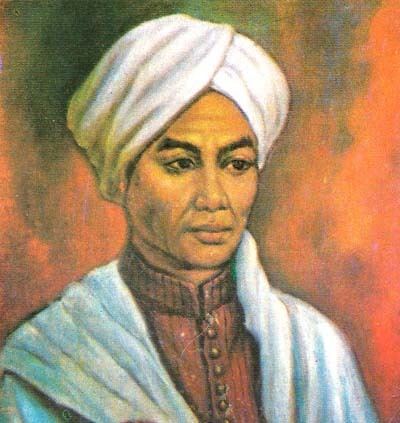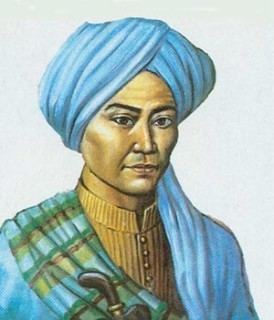Name Bendara Antawirya House Hamengkubuwana Spouse R.A. Retnodewati Nationality Indonesian | Mother Mangkarawati Father Hamengkubuwana III Children Bagus Singlon | |
 | ||
Born 11 November 1785Yogyakarta Sultanate ( 1785-11-11 ) Issue 17 sons and 5 daughters Parents R.A. Mangkarawati, Hamengkubuwono III Similar People | ||
Prince Diponegoro (born Bendara Raden Mas Mustahar; later Bendara Raden Mas Antawirya) (11 November 1785 – 8 January 1855), also known as Dipanegara, was a Javanese prince who opposed the Dutch colonial rule. The eldest son of the Yogyakartan Sultan Hamengkubuwono III, he played an important role in the Java War between 1825 and 1830. After his defeat and capture, he was exiled to Makassar, where he died.
Contents

His five-year struggle against the Dutch control of Java has become celebrated by Indonesians throughout the years, acting as a source of inspiration for the fighters in the Indonesian National Revolution and nationalism in modern-day Indonesia among others. He is a national hero in Indonesia.

Profil pangeran diponegoro
Early life

Diponegoro was born on 11 November 1785 in Yogyakarta, and was the eldest son of Sultan Hamengkubuwono III of Yogyakarta. During his youth at the Yogyakartan court, major occurrences such as the dissolution of the VOC, the British invasion of Java, and subsequent return to Dutch rule. During the invasion, the Sultan Hamengkubuwono II, pushed aside in his power on 1810 in favor of Diponegoro's father, used the general disruption to regain control. In 1812 however he was once more removed from the throne and exiled off-Java by the British forces. In this process, Diponegore acted as an adviser to his father and had apparently provided aid to the British forces to the point where Raffles offered him the Sultan title which he declined, perhaps due to the fact that his father was still reigning.
When the sultan died in 1814, Diponegoro was passed over for the succession to the throne in favor of his younger half brother, Hamengkubuwono IV (r. 1814-1821), who was supported by the Dutch despite the late Sultan's urging for Diponegoro to be the next Sultan. Being a devout Muslim, Diponegoro was alarmed by the relaxing of religious observance at his half brother's court in contrast with his own life of seclusion, as well as by the court's pro-Dutch policy.

In 1821, famine and plague spread in Java. Hamengkubuwono IV died on 1822 under mysterious circumstances, leaving only an infant son as heir. When the year-old boy was appointed as Sultan Hamengkubuwono V, there was a dispute over his guardianship. Diponegoro was again passed over, though he believed he had been promised the right to succeed his half brother - even though such a succession was illegal under Islamic rules. This series of natural disasters and political upheavals finally erupted into full-scale rebellion.
Rebellion against the Dutch

Dutch colonial rule was becoming unpopular among local farmers because of tax rises, crop failures and among Javanese nobles because the Dutch colonial authorities deprived them of their right to lease land. Diponogoro was widely believed to be the Ratu Adil, the just ruler predicted in the Pralembang Jayabaya. Mount Merapi's eruption in 1822 and a cholera epidemic in 1824 furthered the view that a cataclysm is inbound, eliciting widespread support for Diponegoro.

In the days leading up to the war's outbreak, no action was taken by local Dutch officials although rumors of his upcoming insurrection had been floating about. Prophesies and stories, ranging from visions from the tomb of Sultan Ageng Tirtayasa to his contact with Nyai Roro Kidul, spread across the populace.

The beginning of the war saw large losses on the side of the Dutch, due to their lack of coherent strategy and commitment in fighting Diponegoro's guerrilla warfare. Ambushes were set up, and food supplies were denied to the Dutch troops. The Dutch finally committed themselves to controlling the spreading rebellion by increasing the number of troops and sending General De Kock to stop the insurgency. De Kock developed a strategy of fortified camps (benteng) and mobile forces. Heavily-fortified and well-defended soldiers occupied key landmarks to limit the movement of Diponegoro's troops while mobile forces tried to find and fight the rebels. From 1829, Diponegoro definitively lost the initiative and he was put in a defensive position; first in Ungaran, then in the palace of the Resident in Semarang, before finally retreating to Batavia. Many troops and leaders were defeated or deserted.
Defeat and exile
In 1830 Diponegoro's military was as good as beaten and negotiations were started. Diponegoro demanded to have a free state under a sultan and wanted to become the Muslim leader (caliph) for the whole of Java. In March 1830 he was invited to negotiate under a flag of truce. He accepted but was taken prisoner on 28 March despite the flag of truce. De Kock claims that he had warned several Javanese nobles to tell Diponegoro he had to lessen his previous demands or that he would be forced to take other measures. The Dutch exiled him to Makassar.
Legacy
Today Diponegoro is a National Hero of Indonesia, and Kodam IV/Diponegoro, the Central Java Military Region, is named after him. The Indonesian Navy has named two ships after him. The first of these was the lead ship Diponegoro: a Sigma-class corvette purchased from the Netherlands. The most recent is the KRI Diponegoro-365.
